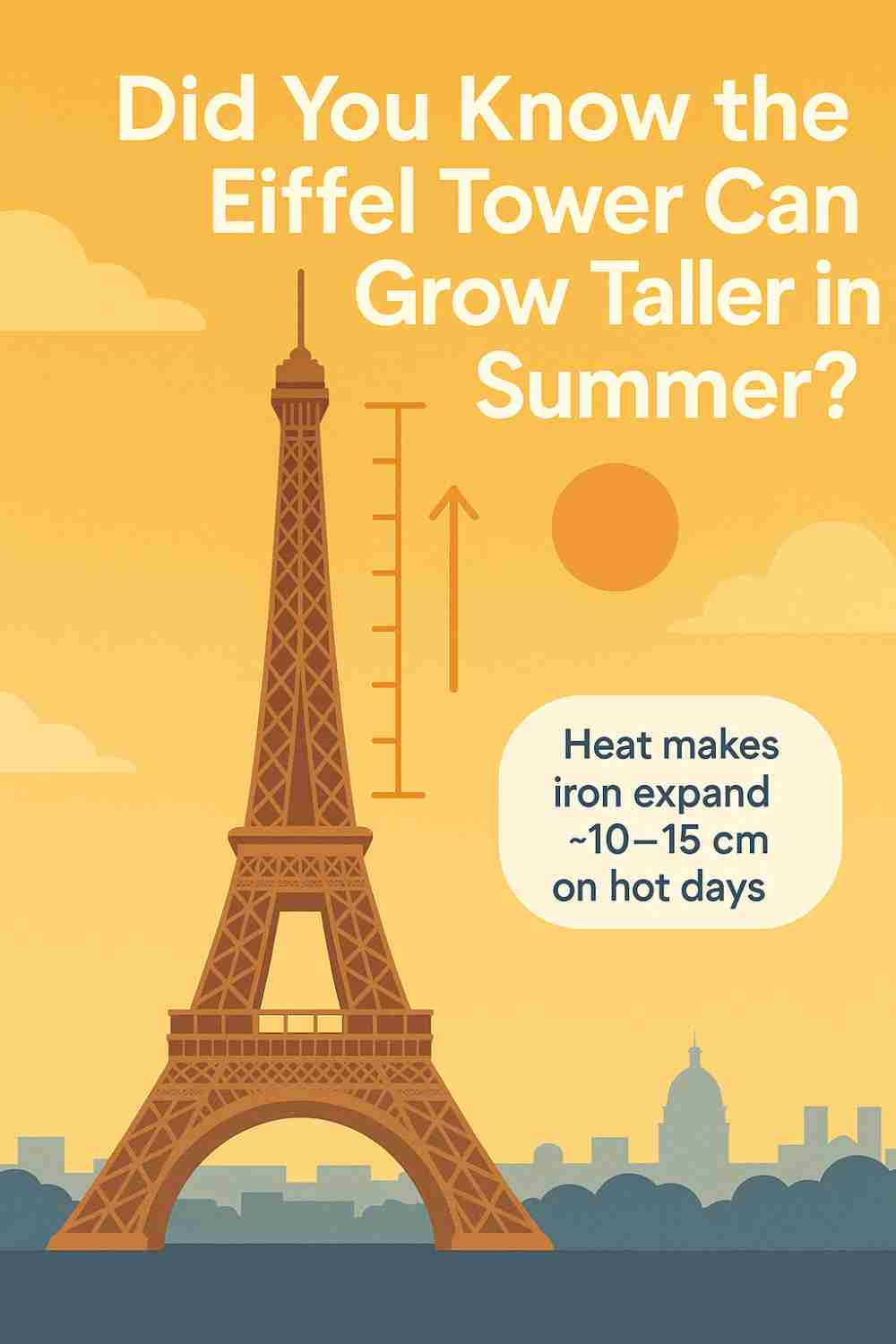 You see a 19th-century iron lattice. Engineers see a giant thermometer you can climb. When the weather warms up, the Eiffel Tower subtly stretches. Not because it’s “growing” in the living-thing sense, but because metal expands when heated. Stand beneath it on a hot July afternoon and you’re looking at a tower that’s literally a bit taller than it was at dawn.
You see a 19th-century iron lattice. Engineers see a giant thermometer you can climb. When the weather warms up, the Eiffel Tower subtly stretches. Not because it’s “growing” in the living-thing sense, but because metal expands when heated. Stand beneath it on a hot July afternoon and you’re looking at a tower that’s literally a bit taller than it was at dawn.
Let’s unpack the “why,” the “how much,” and what it means for anyone planning a visit.
Why the Eiffel Tower gets taller in summer
The Tower isn’t steel; it’s puddled iron (a type of wrought iron) held together with millions of rivets. Iron’s atoms vibrate faster as temperature rises. More motion means a little more space between atoms. Add up that tiny spacing across hundreds of meters and you get measurable change.
Engineers describe this with a simple idea: linear thermal expansion. Each material has a “how stretchy with heat” number called a coefficient. For iron, it sits around 11–12 × 10⁻⁶ per °C. Translate that to everyday terms:
For every 1°C rise in temperature, one meter of iron grows by roughly 0.011–0.012 millimeters.
Scale that to 330 meters of tower (tip included) and you’re at about 3.5–4 millimeters per degree.
A sunny afternoon can swing surface temperatures by 30–40°C compared with a cool morning. Multiply that out and you land in the 10–15 centimeters range of extra height. Not myth. Math.
How much taller are we talking about?
On the hottest days, the Eiffel Tower can gain up to about 15 centimeters—roughly the height of a soda can. It’s not constant. The change ebbs and flows with sun angles, wind, cloud cover, even how heat soaks into different parts of the lattice.
Important detail: the expansion isn’t perfectly uniform. South-facing iron bakes harder. Shadowed zones lag. So the tower doesn’t just grow; it can lean a touch away from the sun as one side warms more. We’re still talking centimeters at the top, not meters. You won’t see it with the naked eye unless you’re measuring.
No, it’s not dangerous
Gustave Eiffel built a climber, not a statue. The lattice design spreads loads and invites airflow. Joints and members were detailed to flex, not fight, with temperature. Expansion and contraction were on the drawing board in the 1880s, long before the first visitor bought a ticket.
Elevator teams expect it, too. Cable lengths, hydraulic pressures, and alignment checks get adjusted for heat and cold so rides stay smooth. Daily operations include temperature-aware safety rules. That little summer stretch is part of the normal life of the monument.
A quick back-of-the-napkin calculation
If you like numbers, here’s a friendly way to see it:
Coefficient for wrought iron: ≈ 12 × 10⁻⁶ /°C
Height considered: ≈ 330 m
Hot day surface change: say 35°C from cool morning to peak heat
ΔL = α × L × ΔT
ΔL ≈ 12e-6 × 330 × 35 ≈ 0.1386 m → 13.9 cm
That’s the simple, straight-line estimate. Real-world results wiggle around that value because temperatures aren’t uniform, the tower isn’t a single bar, and the antenna adds complexity. But you get the idea.
Does it shrink in winter?
Absolutely. Cold tightens the lattice. Cooler atoms don’t vibrate as much, so they cozy up and the tower settles by a similar amount. If you could time-lapse the year, you’d watch a very dignified iron giraffe breathe in and out with the seasons. Engineers plan maintenance with this cycle in mind: paint behaves differently in heat and cold, bearings and bolts tell different stories under different temperatures, and inspection schedules account for it.
What visitors actually notice (and what you won’t)
You won’t feel the height gain under your feet. There’s no “pop” or “creak” moment when the tower hits its summer stride. What you might notice:
Elevators: crew may run slightly different protocols on very hot days.
View timing: heat haze can soften distant horizons at midday; mornings and evenings often give crisper views.
Shade vs. sun: one side of the tower will be warmer; platforms can feel different as you walk around.
That’s about it. The height change is a fun fact to tell your travel buddy while you split a baguette. It won’t change your plan to watch the lights sparkle at night.
Why iron, anyway?
In 1889, iron was the wonder material. Strong in tension and compression, available at scale, and weld-free construction with rivets made sense for the era. The open lattice keeps weight down and wind loads manageable. That lattice also helps with heat: less solid surface to soak sun, more air to carry heat away. If the Tower were a solid wall of metal, the height changes would be bigger and the daily thermal “mood swings” harsher.
Sun, shade, and a tiny tilt
Here’s a quirk: stand on the Champ de Mars at noon on a hot, clear day. The south-facing legs bathe in sunlight. The north-facing legs enjoy a bit more cool. Uneven heating means uneven expansion. The top can drift slightly toward the cooler side. Engineers have measured noticeable but small lateral shifts driven by sunshine alone. Again, nothing dramatic—just a gentle, measurable nudge.
Climate and hotter summers
Hot spells test any large metal structure. The Eiffel Tower is monitored. Sensors, inspections, and strict operating thresholds keep things safe. A few extra millimeters of seasonal stretch don’t change the fundamentals. If conditions move outside playbook ranges—wind, heat, storms—access can be limited until it’s prudent to reopen. The tower’s caretakers are conservative by design. That’s why it’s still here, still stunning.
Is the antenna part of the story?
The tower’s overall height includes its broadcast antenna. Antennas add length, materials, and joints with their own thermal behavior. The lattice and the antenna don’t expand identically, but they move together as a system. When you hear “the Eiffel Tower grows in summer,” that’s the whole assembly—iron body plus antenna—doing its slow, precise stretch.
The paint job isn’t just pretty
That signature gradient—darker at the bottom, lighter at the top—does more than flatter the skyline. Color and coatings influence how much heat sunlight pulls into the metal. Protective paint limits corrosion, seals out moisture, and modulates heat absorption. Repainting cycles are a big deal: many tons of old paint removed, many tons of fresh coats applied, with strict safety and environmental protocols. Heat expansion is one of the many factors crews manage while dangling hundreds of meters up with a brush.
If you love the engineering, you’ll love the sources
Want the monument’s latest official updates, visitor info, and technical tidbits straight from the caretakers? Check the Eiffel Tower’s official site. Curious about the physics behind all this? Here’s a clear overview of thermal expansion that keeps the math friendly and the concepts solid.
Takeaways to tuck in your pocket
The Eiffel Tower does get taller in summer, by around 10–15 cm on very hot days.
Heat makes iron expand; cold makes it contract. Totally normal.
Uneven sun can make the tower lean a tiny bit during the day.
Engineers design, monitor, and operate the structure with this in mind.
You won’t feel the change, but now you’ll know it’s happening—and that’s half the fun.
Next time someone tells you Paris doesn’t change, smile. On a bright summer afternoon, the city’s most famous landmark is literally reaching for the sky.
